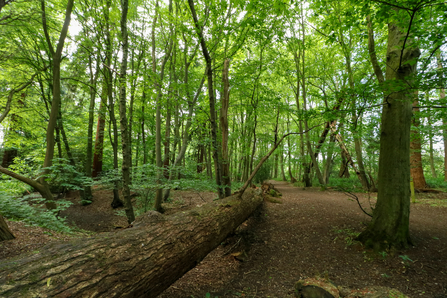Herts Environmental Records Centre (HERC) carry out fantastic work managing information on habitats, species and sites across the county. The data, which is provided by recorders, professional ecologists and the general public, serves many purposes, including conservation, development planning and research. HERC is hosted by the Trust and has close ties with Hertfordshire County Council and Herts Natural History Society
With over three million records and 150,000 new ones being added each year, they are able to provide us with a comprehensive ecological picture of our county.
The Ancient Woodland Inventory
Right now, HERC are contributing to an update of The Ancient Woodland Inventory (AWI), a national survey, which is being coordinated by Natural England. The original dataset identifies over 52,000 ancient woodland sites in England, with 842 woodlands in Hertfordshire, ranging in size from small woodland parcels to massive woodland complexes.
What is an ancient woodland?
A woodland is described as ancient if it has been continuously wooded since at least 1600 AD. There are two categories of ancient woodland:
Ancient Semi-Natural Woodland – woodland retaining naturally occurring native tree and shrub cover, including those that have been managed and allowed to naturally regenerate.
Plantation on Ancient Woodland Sites – woodland where the original trees have been felled and replaced, often with conifers, but ancient woodland features, such as undisturbed soil, ground flora and fungi are retained.
These habitats have developed relatively undisturbed for centuries and are highly valued – they have complex soil communities, support an array of wildlife, including many rare and protected species that only exist in these sites. They also capture and store carbon, making them important allies in fighting the climate crisis. Irreplaceable if destroyed, ancient woodlands are considered to be one of our most important habitats.
Background to the survey
The last survey of these important habitats was carried out over 30 years ago – since then, there have been huge advances in digital mapping and improvements in the methods of identifying ancient woodland which has led to the need to update the dataset. The AWI update will:
- Allow for the incorporation of new evidence to support ancient woodland classification.
- Improve on the accuracy and precision of existing ancient woodland boundaries, and remove mapping errors created when the original dataset was digitised.
- Identify omissions from the original dataset, including any ancient woodland parcels smaller than 2 hectares and wood pastures (another important ancient habitat).
What is HERC’s role in this?
HERC have already carried out an initial phase of the project, highlighting potential changes to the current Inventory, comparing current woodland cover using aerial imagery with mapping from the 1800s and the existing Inventory. From here, the dataset will be refined – a complex task using historic maps to identify presence or absence of woodland, which will be studied by a local landscape historian, alongside evidence from field surveys over the spring and summer. A new data officer has recently been recruited to deliver the project in Hertfordshire, following Natural England’s guidelines.
What will the Inventory tell us?
The information recorded about each wood will include its grid reference, its area in hectares and how much of that woodland is semi-natural or replanted. The updated AWI will be the most accurate/complete dataset to date of ancient woodland in England.
How can I get involved?
HERC are actively seeking volunteers who are able to support the project during the spring and summer of 2023. Under guidance, this will include collecting evidence of ancient woodland features. The records centre would also like to hear from woodland owners, who believe it may be ancient, with a view to potentially arranging a survey during the same period, subject to availability. To start a conversation about either, please email enquiries@hercinfo.org.uk


